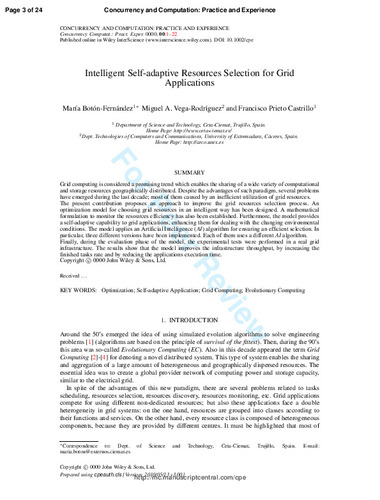Intelligent self-adaptive resources selection for grid applications
Autor(es) y otros:
Palabra(s) clave:
optimization; self-adaptive application; grid computing; evolutionary computing
Fecha de publicación:
Versión del editor:
Citación:
Descripción física:
Resumen:
Grid computing is considered a promising trend, which enables the sharing of a wide variety of computa- tional and storage resources geographically distributed. Despite the advantages of such paradigm, several problems have emerged during the last decade; most of them caused by an inefficient utilization of grid resources. The present contribution proposes an approach to improve the grid resources selection process. An optimization model for choosing grid resources in an intelligent way has been designed. A mathematical formulation to monitor the resources efficiency has also been established. Furthermore, the model provides a self-adaptive capability to grid applications, enhancing them for dealing with the changing environmen- tal conditions. The model applies an artificial intelligence algorithm for ensuring an efficient selection. In particular, three different versions have been implemented. Each of them uses a different algorithm. Finally, during the evaluation phase of the model, the experimental tests were performed in a real grid infrastructure. The results show that the model improves the infrastructure throughput, by increasing the finished tasks rate and by reducing the applications execution time.
Grid computing is considered a promising trend, which enables the sharing of a wide variety of computa- tional and storage resources geographically distributed. Despite the advantages of such paradigm, several problems have emerged during the last decade; most of them caused by an inefficient utilization of grid resources. The present contribution proposes an approach to improve the grid resources selection process. An optimization model for choosing grid resources in an intelligent way has been designed. A mathematical formulation to monitor the resources efficiency has also been established. Furthermore, the model provides a self-adaptive capability to grid applications, enhancing them for dealing with the changing environmen- tal conditions. The model applies an artificial intelligence algorithm for ensuring an efficient selection. In particular, three different versions have been implemented. Each of them uses a different algorithm. Finally, during the evaluation phase of the model, the experimental tests were performed in a real grid infrastructure. The results show that the model improves the infrastructure throughput, by increasing the finished tasks rate and by reducing the applications execution time.
ISSN:
DOI:
Colecciones
Ficheros en el ítem




